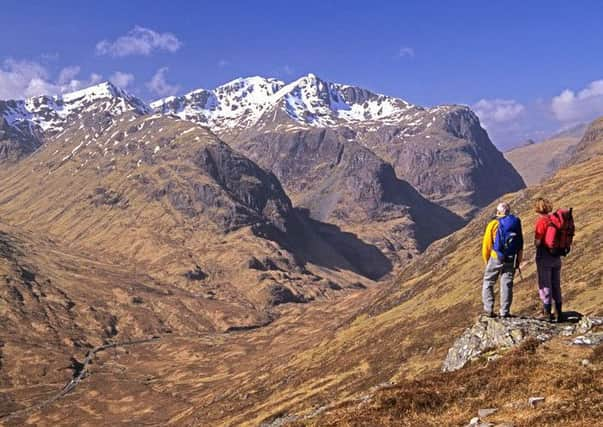Helen Todd: Walking is good for more than just the soul


It’s the time of year when tourism businesses across Scotland are gearing up for a huge influx of visitors looking to enjoy the best our stunning country has to offer – and to spend their hard-earned cash. Walking, recreation and the outdoors are vital to Scotland’s economic success. The value of this industry was clearly demonstrated 15 years ago, when much of the British countryside was closed to visitors as foot and mouth disease gripped the country. Businesses such as cafes and B&Bs, caravan sites and tour-guiding companies struggled to survive and some went out of business altogether. It’s estimated that the tourism industry across Britain lost more than £5 billion of income during the crisis.
Walking itself may be free but people spend money on the pre-walk cup of tea, the map from the local shop, the overnight stay in a hotel or B&B, the petrol from the local garage, or the professional guide. These might seem like relatively small outlays, but the individual spends add up to impressive totals when multiplied by the millions of people who visit Scotland each year.
Advertisement
Hide AdAdvertisement
Hide AdIn 2012 Scottish Natural Heritage estimated expenditure of a whopping £2.6bn related to outdoor recreation visits by Scots alone.
This was reinforced earlier this year when the Scottish Marine Recreation and Tourism Survey was published demonstrating this sector is worth £3.7bn, covering activities ranging from whale watching boat trips to coastal walks. Outdoor recreation is not just a nice leisure activity, it also makes a substantial contribution to the Scottish economy, particularly in rural areas.
So it’s important that governments at local and national levels ensure that outdoor recreation is supported with investment. An open, welcoming countryside is a vital component of the tourist industry. Outdoor access should not be seen as a luxury, sidelined in times of austerity, but paths need to be developed, maintained and promoted, and obstructions removed. Good path networks attract visitors but they are also assets for communities across the country, giving them valued opportunities to get outdoors easily into their local greenspaces and the surrounding area. Paths also attract people to live and work in these places as it’s recognised that access to green networks is part of a good quality lifestyle.
In addition, long distance routes can bring huge economic benefits. A study of the Fife Coastal Path in 2006 demonstrated its value both locally and nationally with over half a million visits each year contributing to around £25 million of expenditure and supporting over 800 FTE jobs in Fife. While half of the path users were on short trips from their homes, a quarter were on holiday, including visitors from overseas. Other communities across Scotland have recognised the value to be gained from developing long distance routes to showcase their areas, and routes such as the Kintyre Way, Cowal Way and East Highland Way have sprung up in recent years as local initiatives.
But as well as direct expenditure from recreation, let’s not forget there are also huge benefits to be gained at a population level if outdoor recreation is enjoyed by more people. Indirectly, investment in getting people more active is hugely important as part of the preventative spend agenda. Physical inactivity contributes to 2,500 premature deaths which costs the Scottish economy £660m a year. If we were all more active, these costs would be largely preventable. The annual cost to the NHS of physical inactivity is £94m, money which could be better spent elsewhere.
As well as encouraging more outdoor recreation, a simple way to improve physical activity levels is to help people have more active lifestyles. By developing safe, pleasant path networks, these could be used to walk or cycle to work, school or the shops as well as being part of the recreational path network. The Scottish government still only spends around 2 per cent of its transport budget on walking and cycling but increasing this investment would also bring extra benefits in terms of reducing air pollution and congestion and helping to tackle the growing obesity problem.
The Scottish government has ambitions to get Scots of all ages and backgrounds to be more active. We believe investment in walking, outdoor recreation and active travel could help to bring about a change in culture and behaviour across Scotland leading to healthier lifestyles, while at the same time supporting thousands of small businesses. If you think so too, why not contact your new MSP to remind them just how important walking is to the health of your local community and economy?
• Helen Todd, Ramblers Scotland